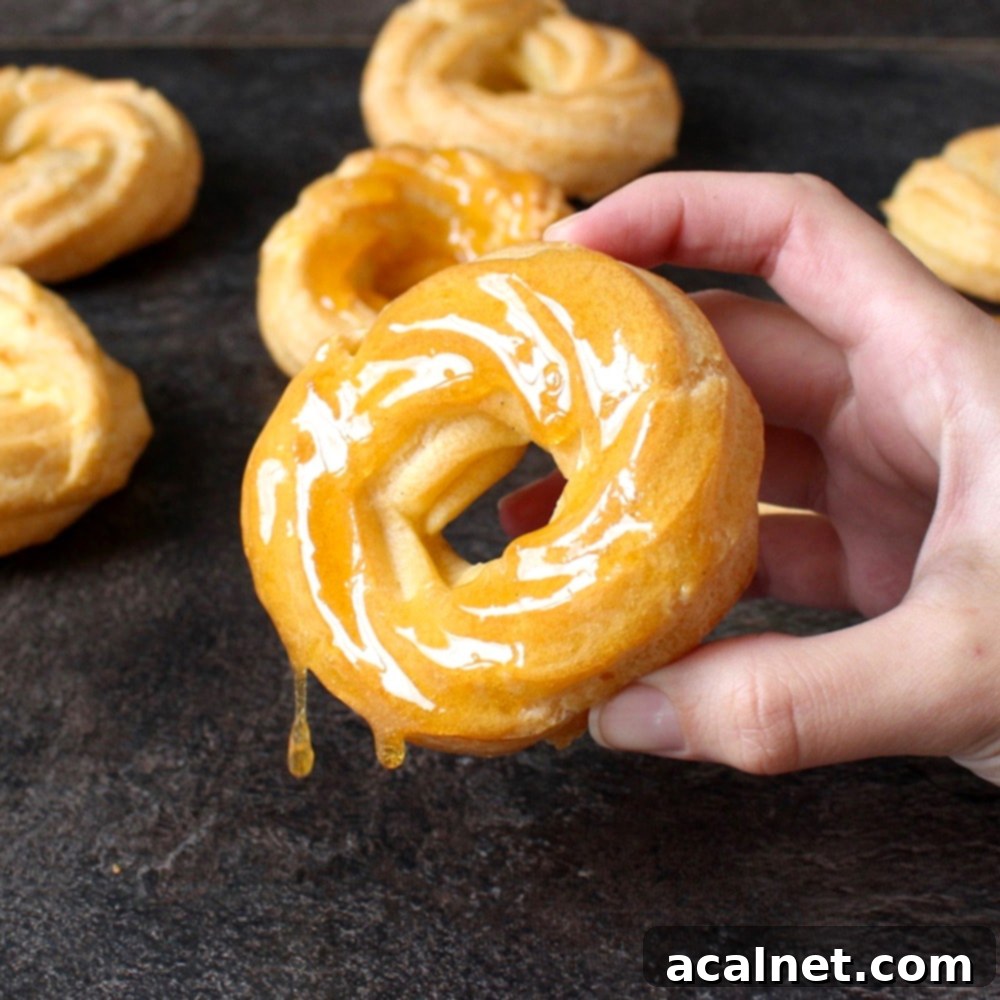Irresistible Honey Lemon Glazed French Cruller Donuts: A Choux Pastry Delight
Stepping into the world of French Cruller Donuts was a delightful revelation not long ago, and it quickly became a recipe I simply had to master. The very idea of a donut crafted from delicate choux pastry, baked to a golden crisp, intrigued me immensely. My culinary exploration culminated last week with a batch of Honey Lemon Glazed Cruller Donuts that were nothing short of spectacular. These sweet treats, with their unique texture and vibrant glaze, truly blew me away, proving that sometimes, the most unexpected combinations yield the most delicious results. If you’re looking for a dessert that’s both elegant and incredibly satisfying, you’ve found your next baking adventure.
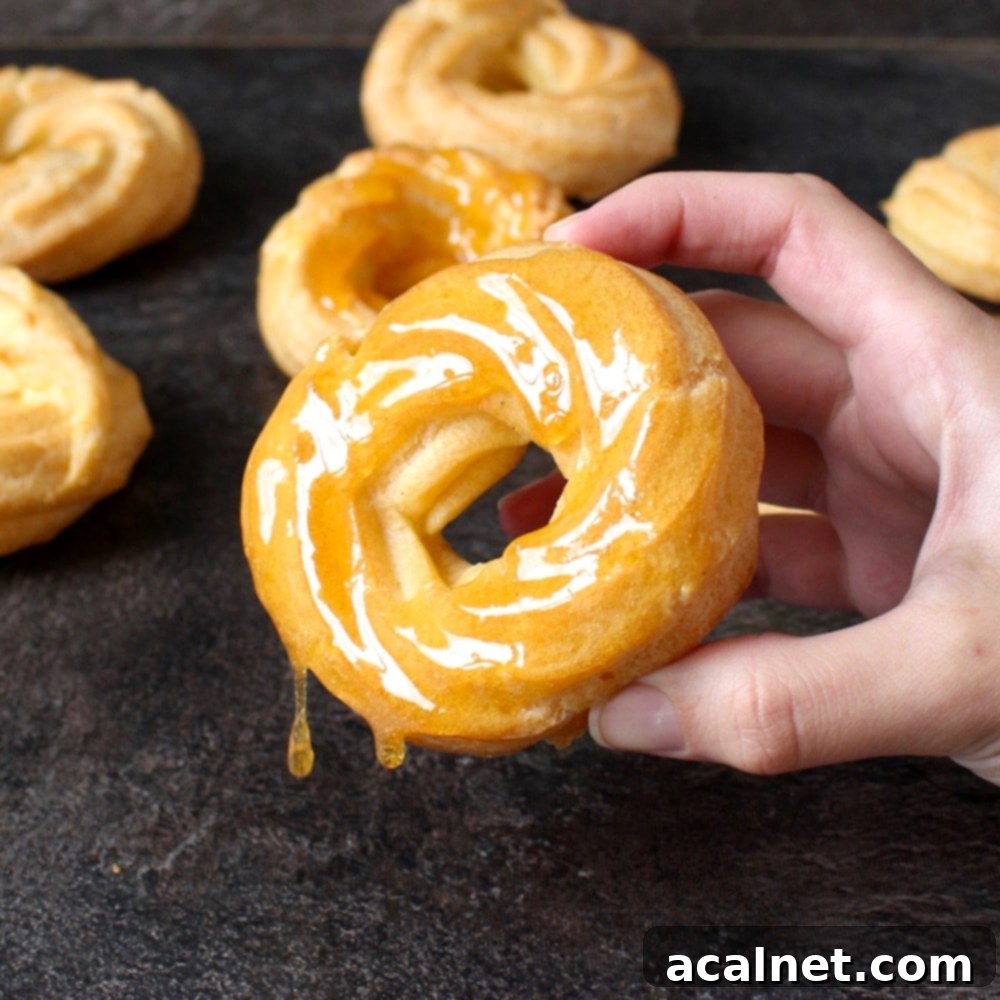
Admittedly, before a chance encounter on Pinterest a few weeks ago, the term “French Cruller Donuts” wasn’t part of my baking vocabulary. My initial thought was: Baked Donuts made from Choux Pastry? This sounded utterly fascinating and utterly delicious. Of course, such an intriguing concept demanded immediate investigation. And by “investigation,” I mean a hands-on culinary experiment involving making and, naturally, eating a generous amount of them. All in the name of scientific discovery and gastronomic research, of course!
The journey to creating these exquisite pastries was as rewarding as the tasting itself. There’s a certain magic in transforming simple ingredients into something so light, airy, and utterly satisfying. Forget everything you thought you knew about traditional donuts; French Crullers offer a sophisticated twist that elevates the humble donut to an art form.
What Are French Crullers Made Of? Unveiling Their Unique Charm
French Crullers are a distinct type of donut, instantly recognizable by their signature ridged, often circular, shape and their incredibly light, airy texture. What sets them apart from most other donuts is their foundation: they are made from Choux Pastry, or Pâte à Choux in French. Unlike dense cake donuts or chewy yeast donuts, crullers boast an ethereal lightness that melts in your mouth.
This unique pastry can be either oven-baked or deep-fried, and typically finished with a sweet glaze or icing. The resulting donut is far lighter, fluffier, and softer than conventional varieties. This exceptional texture is a direct result of the Choux Pastry, which creates a hollow interior and a delicate crisp exterior, rather than the more substantial crumb of a cake batter or yeast dough. Each bite delivers a delightful contrast: a slightly crisp outer shell giving way to an incredibly soft, almost custardy, interior.
The Distinctive Difference: Crullers vs. Classic Donuts
While both classic donuts and French Crullers are beloved circular sweet treats, their fundamental difference lies in their dough. This distinction is crucial to understanding their unique characteristics and appeal.
Classic Donuts are remarkably versatile and can be crafted from several types of doughs. Many popular varieties, such as these Bavarian Cream Donuts or Brioche Donuts, begin with a yeast-based dough. This yeast dough typically undergoes a fermentation process, resulting in a light, chewy texture, and often a slightly yeasty flavor. Alternatively, many donuts are made from a cake batter, like these Biscoff Donuts. Cake donuts tend to be denser and more tender, similar to a moist cake, and are often baked in ring-shaped molds. Regardless of the dough type, classic donuts are frequently deep-fried, although baked cake donuts are also popular.
In contrast, Crullers are exclusively made from Choux Pastry. This pastry, piped into a distinctive ring shape, is then either baked or fried. The absence of yeast or traditional leavening agents in choux pastry means its rise comes from steam generated during baking, creating those signature hollow, airy pockets. This fundamental difference in base dough is what gives French Crullers their unparalleled lightness and delicate structure, setting them firmly apart in the vast world of donuts.
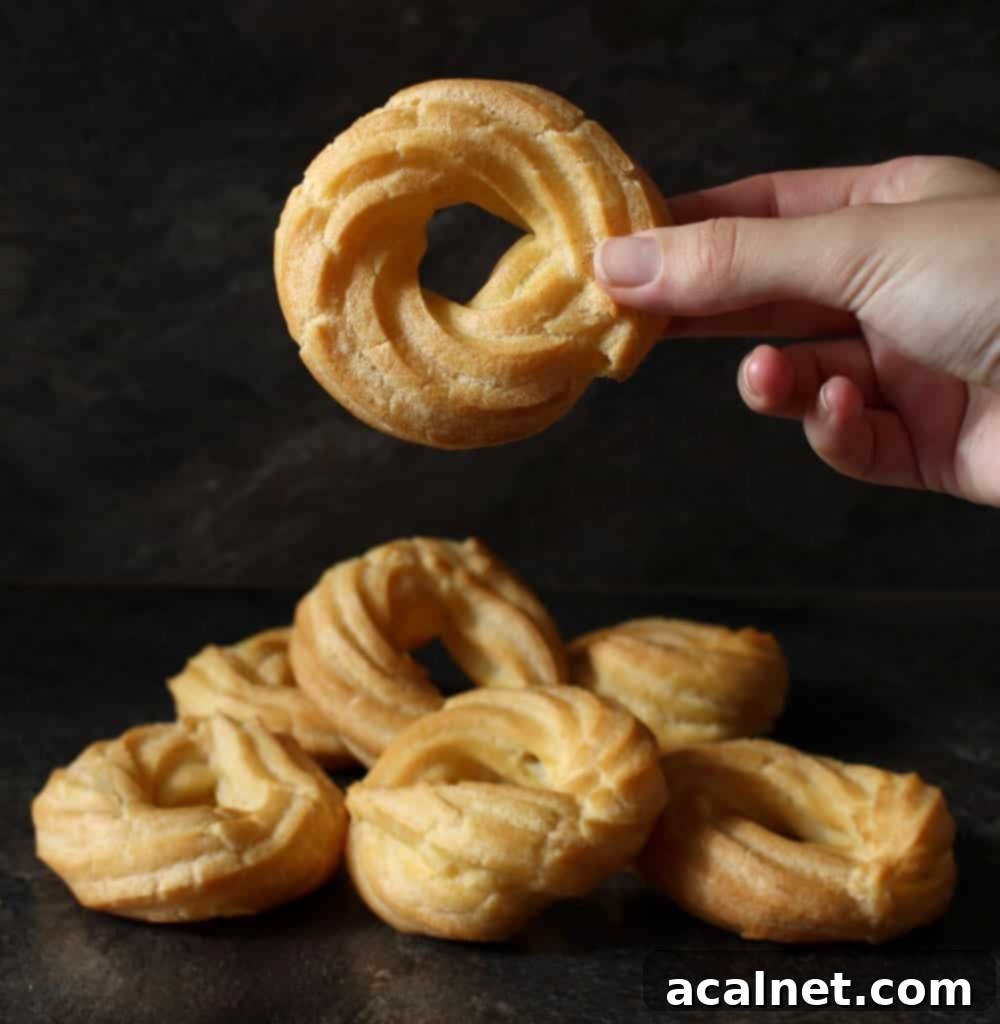
Decoding Choux Pastry: The Heart of Your Crullers
Choux Pastry – or “Pâte à Choux” in its native French – is a true cornerstone of traditional French baking. It’s a remarkably versatile dough that forms the base for an array of classic desserts and pastries, many of which I’ve been exploring recently, such as this Plum Vanilla Custard Tart. Beyond crullers, you’ll find choux pastry in beloved treats like Choux à la Crème (cream puffs) and Choux au Craquelin, which adds a delightful crispy topping.
The most famous applications are arguably Profiteroles (those delightful cream-filled puffs) and elegant Eclairs. While often associated with sweet creations, this humble dough can also be transformed into delicious savory pastries, showcasing its incredible adaptability. It’s a fundamental skill for any aspiring baker to master.
Interestingly, despite the name “French” Crullers, they aren’t commonly found in traditional French bakeries. However, the use of Choux Pastry undeniably links them to French culinary heritage. This recipe, therefore, beautifully marries traditional French technique with a more modern, donut-inspired form, offering a unique and exciting baking experience.
To embark on your choux pastry journey, you only need four incredibly basic ingredients:
- Water
- Butter
- Flour
- Eggs
These are pantry staples, meaning you likely have everything you need to start right now! The process of making the traditional Pâte à Choux involves a unique “twice-baked” method. First, the dough is cooked on the stovetop, and then it’s baked in the oven. This two-stage cooking is crucial for achieving the characteristic airy texture. Once your choux is perfected, you’ll pipe it into elegant donut shapes, bake them to golden perfection, and then, of course, generously glaze them.
The triumph of any Choux creation hinges heavily on how it is baked. The initial stovetop cooking is vital for drying out the dough, creating a thick base (called a panade). This process allows the gluten in the flour to develop properly. After cooling slightly, eggs are vigorously mixed in, adding new moisture and air. When this dough hits the high heat of the oven, the moisture rapidly turns to steam, causing the pastry to puff up dramatically and create its signature hollow interior. This scientific dance is what makes choux pastry so magical.
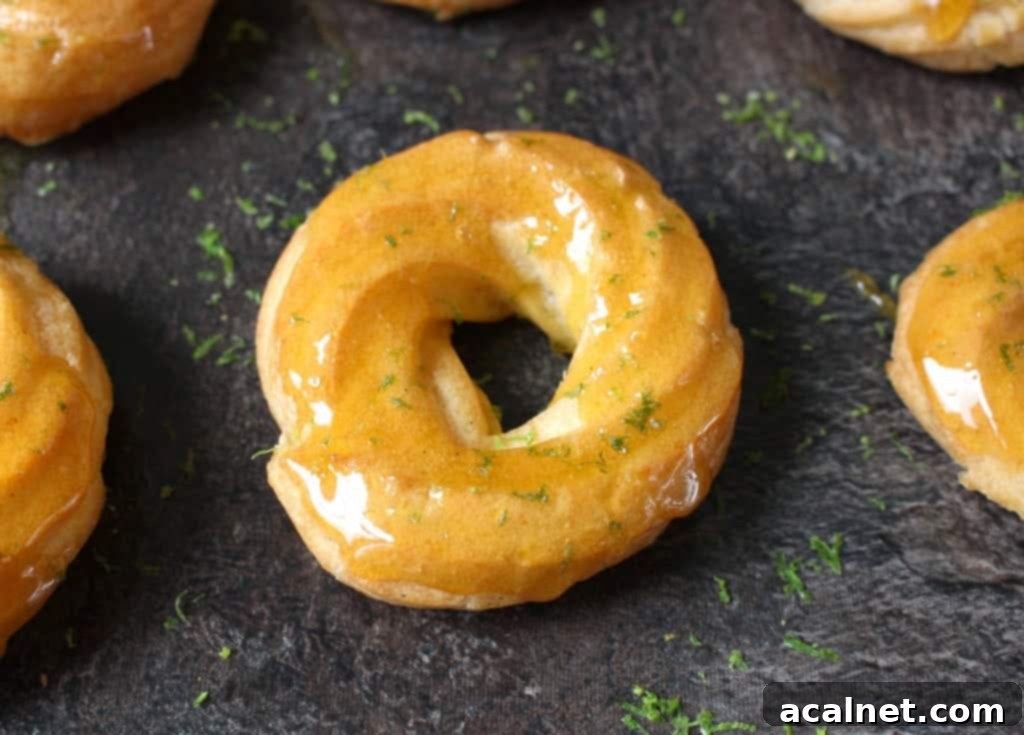
Mastering Baked French Cruller Donuts: Lighter, Fluffier, Healthier?
The success of the ethereal rise in choux pastry hinges significantly on the moisture content of the dough. This is precisely why the initial stovetop cooking stage – drying out the dough to form what bakers call a “panade” – is absolutely critical. During this step, you’re essentially cooking out excess water, allowing the gluten in the flour to strengthen and develop. Once sufficiently dried, the eggs are gradually beaten in, reintroducing moisture and air, which are then trapped within the gluten network. When this prepared dough is introduced to the hot oven, the trapped air and moisture rapidly expand, transforming into steam. This steam then dramatically puffs up the pastry, creating those desirable hollow interiors and crisp exteriors characteristic of perfectly baked choux.
When executed correctly, the result is an extraordinarily light, fluffy, and richly eggy pastry. A major advantage of making Baked French Cruller Donuts is that they offer a considerably “healthier” alternative to their deep-fried counterparts. By baking them in the oven, you eliminate the need for large quantities of frying oil, reducing the overall fat content. While it’s true that French pastry still involves butter (and a good amount of it!), opting for baked over fried undeniably makes these crullers a lighter indulgence. So, yes, “healthy donuts” might sound like an oxymoron, but among the many different types of donuts available, these baked choux crullers are certainly a more guilt-free pleasure.
Once your choux pastry reaches its perfect consistency, the next fun step is piping it into beautiful donut shapes. The choice of piping tips allows for creative freedom, enabling you to achieve various aesthetic looks. For instance, using a good set of decorating tips is an indispensable kitchen essential for any baking enthusiast. To get that classic, beautifully ridged French Cruller Donut appearance, I personally opted for an Open Star Piping tip. This creates those iconic fluted edges that make a cruller so visually appealing and distinct. Once piped, a careful bake in a preheated oven will transform these delicate spirals into golden, airy perfection, ready for their delicious glaze.
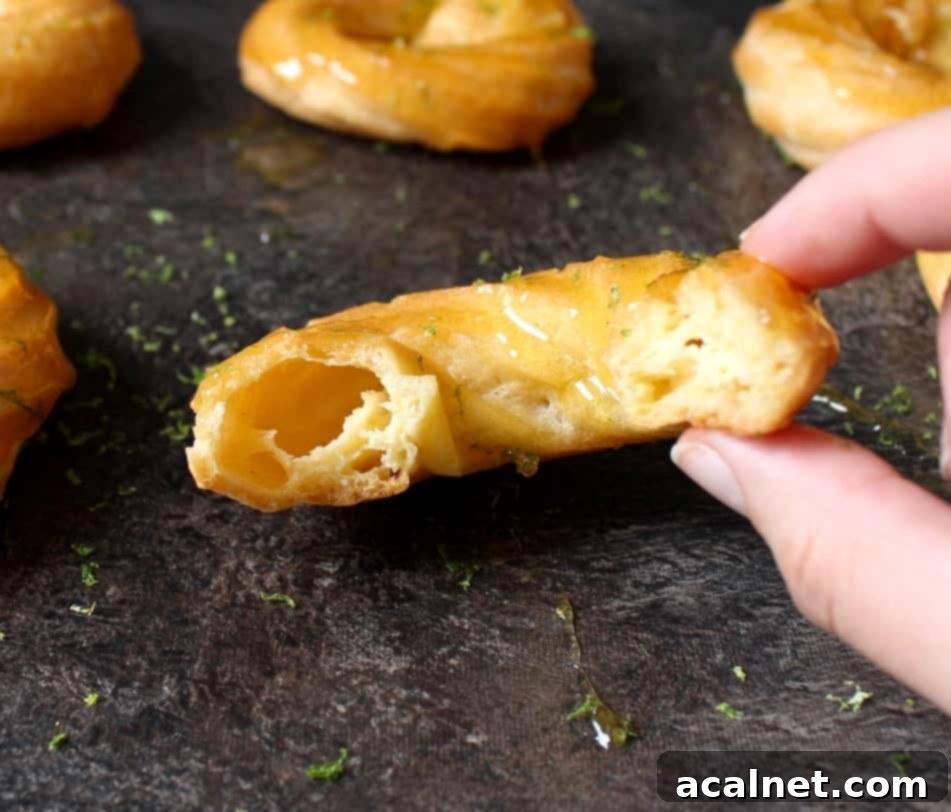
The Perfect Finish: Zesty Honey Lemon Glaze
While Profiteroles or Eclairs traditionally call for a rich cream or ice cream filling, finishing your French Cruller Donuts is wonderfully straightforward – a simple, luscious glaze is all they need. The delicate, airy structure of the cruller doesn’t require a heavy filling; instead, it provides the perfect canvas for a flavorful coating.
For this recipe, I opted for an incredibly easy, two-ingredient glaze that perfectly complements the crullers’ light texture and offers a delightful balance of flavors. You’ll only need:
- Honey
- Fresh Lemon Juice
Creating this irresistible glaze couldn’t be simpler. Combine the honey and lemon juice in a small saucepan over low heat. Gently warm the mixture, stirring occasionally, until the honey is fully melted and seamlessly incorporated with the lemon juice. As soon as it begins to bubble gently, remove it from the heat and allow it to cool down slightly. This brief cooling period helps the glaze thicken just enough to cling beautifully to the crullers without being too thin. Once cooled to a comfortable dipping temperature, simply take each baked cruller and dip it generously into the fragrant glaze, allowing any excess to drip off before placing it on a wire rack to set.
The marriage of sweet honey and tangy lemon is a classic for a reason, creating a bright, refreshing taste that cuts through the richness of the pastry. The Honey Lemon Glaze provides a burst of citrusy zing that makes these crullers truly addictive. I recall making these when I was feeling a bit under the weather, and I conveniently convinced myself that a honey lemon glaze would be not only delicious but also wonderfully soothing for a sore throat. So, yes, my dedication to this recipe was, once again, purely for “scientific” and “medicinal” purposes. Ahem.
For an extra touch of aroma and visual appeal, consider adding a sprinkle of fresh lime zest over the glazed crullers just before they set. The vibrant green specks not only look beautiful but also enhance the citrus notes, taking these already fantastic donuts to another level of deliciousness. This glaze is so versatile that you can even consider experimenting with other citrus juices or a hint of vanilla for different flavor profiles.
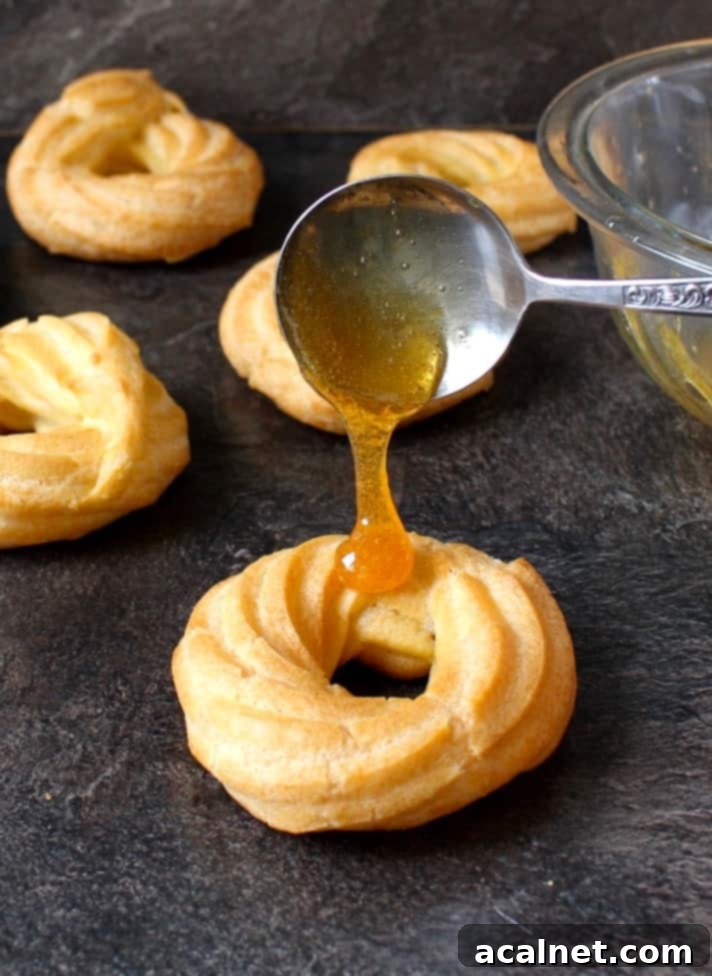
Tips for Perfect French Cruller Donuts
Achieving bakery-quality French Cruller Donuts at home is absolutely within reach with a few key tips and a little patience. Mastering choux pastry is the most important step, and here’s how to ensure success:
- Accurate Measurements: Choux pastry is quite sensitive to ingredient ratios. Use a kitchen scale for flour and butter for the most precise results.
- Proper Panade: Don’t rush the stovetop cooking of the butter, water, and flour mixture. The goal is to dry it out sufficiently until it forms a ball and leaves a thin film on the bottom of the pot. This panade is crucial for developing the right texture.
- Temperature of Eggs: Ensure the panade has cooled slightly before adding the eggs. If the dough is too hot, it will cook the eggs, leading to a scramble instead of a smooth pastry.
- Egg Consistency: Add eggs one by one, mixing thoroughly after each addition. The final dough should be shiny and thick enough to hold its shape but soft enough to pipe. The “V” test (drawing a line with your spoon; if it slowly fills back in, it’s perfect) is a great indicator.
- Piping Technique: For consistent cruller shapes, pipe directly onto parchment paper. You can even draw circles on the back of the parchment as a guide. Overlapping the ends slightly will ensure a closed ring.
- No Peeking in the Oven: Resist the urge to open the oven door during the initial baking phase. The steam trapped inside is essential for the pastry to rise and puff up correctly. Opening the door too soon can cause the crullers to collapse.
- Gradual Cooling: The slight opening of the oven door with a wooden spoon for the last few minutes of baking helps the crullers dry out and crisp up without collapsing. It’s a gentle transition to the outside air.
- Glaze Consistency: If your honey lemon glaze becomes too thick as it cools, a quick 10-second zap in the microwave will bring it back to the perfect dipping consistency.
Following these guidelines will significantly increase your chances of creating beautiful, light, and utterly delicious French Cruller Donuts every time.
Storing Your Delicious Crullers
French Cruller Donuts are best enjoyed fresh, ideally on the day they are made, when their crisp exterior and airy interior are at their peak. However, if you find yourself with leftovers (a rare occurrence, perhaps!), proper storage can help maintain their quality for a short period.
- Room Temperature: Store unglazed crullers in an airtight container at room temperature for up to 1-2 days. If they are glazed, the glaze might become sticky or softer over time, but they can still be stored in an airtight container for a day.
- Refrigeration: While not ideal for maintaining crispness, glazed crullers can be refrigerated in an airtight container for up to 2-3 days. Bring them to room temperature before serving for the best flavor.
- Freezing: Unglazed, baked crullers can be frozen for up to 1 month. Wrap them tightly in plastic wrap and then place them in a freezer-safe bag or container. Thaw at room temperature and then re-crisp in a preheated oven (about 300°F/150°C) for a few minutes before glazing and serving. This is a great option for prepping ahead!
Keep in mind that the unique texture of choux pastry will soften over time, particularly after glazing. For the ultimate experience, try to enjoy them as close to baking as possible!
More Sweet Treats to Explore:
- Chocolate Caramel Slices
- Chocolate Raspberry Brownies
- Mini Lemon Blueberry Bundt Cakes
- Coffee Choux Buns
- Mini Blood Orange and Semolina Cakes
- Chocolate Brownie Bites
- French Strawberry Custard Tartlets
Recipe

Honey Lemon Glazed French Cruller Donuts
Print Recipe
Ingredients
Choux Pastry
- 250 ml (1 cup) Water
- 120 gr (1/2 cup) Butter
- 140 gr (1 cup) Plain Flour
- 3 Eggs
Honey Lemon Glaze
- 3 tbsp. Honey
- 1 Lemon, Juiced
- 1 Lime, Zest (Optional)
Instructions
Choux Pastry
- Place the Water and Butter in a pot and bring to a boil.
Remove from the heat and drop the Flour in the liquid at once.
Mix well with a wooden spoon or spatula until a smooth ball forms. The dough shouldn’t stick to the edges of the pot.
- Place the pot back on to the stove on low temperature for a couple of minutes while mixing the dough with the wooden spoon. You want to press the dough against the edges on the pot to allow for the heat to dry the dough.
Continue the process until you stop seeing steam coming out of the dough – that means that all the moisture is gone.
- Remove from the stove and let the dough cool down for a few minutes.
Add the Eggs one by one, mixing them into the dough each time. You want to make sure the dough is not too hot to avoid cooking the eggs.
- To make sure the dough has the right consistency, draw a line with the bottom of your spoon. If the dough slowly fills the hole, the consistency is right. Otherwise, it is either too runny or too hard.
- Preheat your oven to 190°C (375°F).
Place the Choux Pastry in a piping bag with a star-shaped nozzle. On a baking tray lined with baking paper, pipe the dough into small donut shapes.
Place in the oven for 20 minutes. Make sure you do not open the oven door during that time to keep the steam in. For the last 5 minutes of baking, slightly open the oven door and place a wooden spoon in the opening to keep it open.
Remove the Cruller Donuts from the oven and let them cool down completely on a cooling rack.
Honey Lemon Glaze
- Pour the Lemon Juice and Honey into a small pot and bring to a gentle boil over low heat. Remove from the stove as soon as bubbles or foam start appearing.
Let the glaze cool down for a few minutes until it thickens slightly, then dip your cooled Cruller Donuts into it.
If the glaze cools down too fast and becomes too hard to glaze, place it in the microwave for 10 seconds to loosen it up.
- Optional: Sprinkle some Lime Zest over the Cruller Donuts as a garnish for an extra citrus kick.
Would you like to save this recipe?
We’ll email this post to you, so you can come back to it later!
